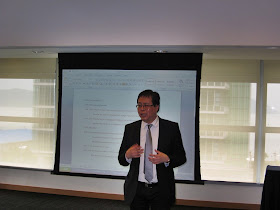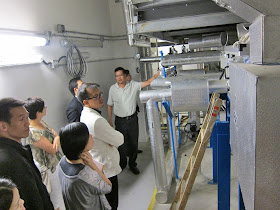In the beginning, I gave a welcome speech and indicated that sustainability was very important in every companies and introduced different parties contributed in the seminar.
Mr. Coleman Tse (General Manager at HKQAA) gave an opening remark. He mentioned an integrated audit named "Energy Cum Audit" which combined with Energy and Carbon audit.
The first speaker was Ms. Caroline Ma (Auditor, Operations Branch, HKQAA) and her topic named "Climate Change & Carbon Smart Program".
Ms. Ma mentioned a global challenge and required actions to reduce greenhouse gas (GHG) emissions. The concentration of CO2 from pre-industrial to present were changed from 280 ppmv to 384 ppmv. Some observations of global warming in Hong Kong were shown in the following diagram.
Then She introduced HKQAA CarbonSmart Program Verification Process which enchanced the brand and corporate reputation by demonstrating commitment to CSR and carbon reduction. During application submission, organization applied for both HKQAA scheme and HKPC for CarbonSmart Fund, as well as, expected schedule of having Carbon Verification Report. The next step was on-site verification and confirmation of that result included carbon inventory figure. When every steps were complied, HKQAA would approve for issuance of Carbon Verification Report.
The second speaker was Mr. Patrick Ho (Consultant, Automotive and Electronics Green Manufacturing & Environmental Consultancy, HKPC) and his presentation named "CarbonSmark" Program.
Firstly, Mr. Ho briefed local trend of carbon management. Based on "Climate Change Business Forum Survey 2012, it collected the percentage of concern on Electricity Cost (79%), Environmental Resource Leakage (78%), Climate Change (77%), etc.
Finally, Mr. Ho introduced CarbonSmart which was a government funded project aimed to encourage and sustain industry effort on carbon audit and reduction to shape a low carbon future. The funding source was from Environment and Conservation Fund. HKPC performed a Carbon Audit Pilot Fund and targeted for 200 companies across 4 business sections (i.e. Office-based operations, Retail, Catering & Others). The fund subsidized up to 50% of the approved cast of carbon audit and the ceiling amount is HK$30,000 for each applicant.
The third speakers were Mr. Howard Yeung (Senior Technical Service Manager, ICC) and Mr. Mick Lai (Property & Facility Manager, ICC) and their topic was "Low Carbon Office in ICC". Mr. Mick Lai introduced the background and mission of their company and Eco-friendly was one of goals.
Then they introduced Low Carbon Office reducing 16,583 CO2 carbon emission annually, and approximately 14% overall energy saving annually, as well as, 39% lighting saving annually. The details of lighting system saving were showed as following table.
Other measures were also mentioned such as Smart Printing & Photocoping (e.g. Using smart card for paper printing like University Library), Water cooled Air-conditioning System, Efficient Lift System, and Building Management System, etc. MVAC System, Lift & Escalator System and Electrical System contributed were identified as significant energy sources. After implemented ISO 50001 Energy Management System, overall electricity efficiency was improved. Electricity consumption was reduced 11% in average comparison between 2012 and 2013 (Jan-Jun).
After the presentation, we took a group photo for memory.
Ms. Danna Pan (Deputy General Manager, AirStar Environment Technology Group (HK) Ltd.) prepared a site visit to Low Carbon Office in Science Park. When we arrived the office, Mr. Otto Tse (General Manager, AirStar Environment Technology Group (HK) Ltd.) introduced their Radiant Ceiling and Fresh Air System (RCF).
The following diagram showed the different of heat transfer paths between RCF and Convection Air-conditioning. We were comfortable in the meeting room for more than 20 people.
Then Mr. Otto Tse showed their RCF system in plant room on-site.
Reference:HKSTPC - http://www.hkstp.org/
HKQAA - http://www.hkqaa.org



















































